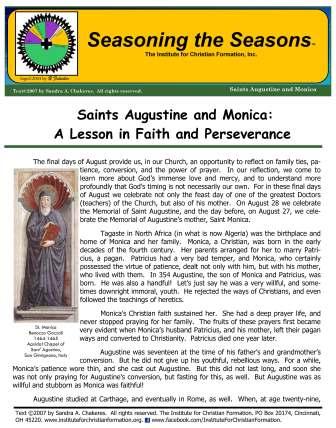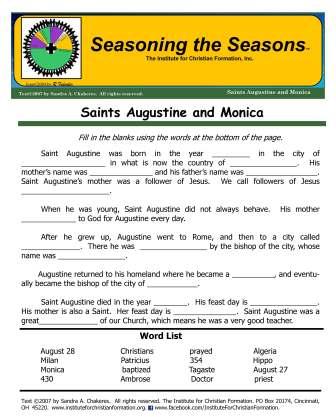The Institute for Christian Formation
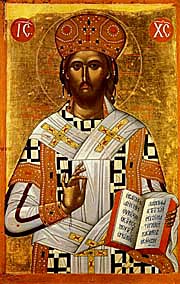
Saint Monica
Feast Day (Memorial): August 27
Saint Augustine, Bishop & Doctor of the Church
Saints Augustine and Monica: A Lesson in Faith and Perseverance
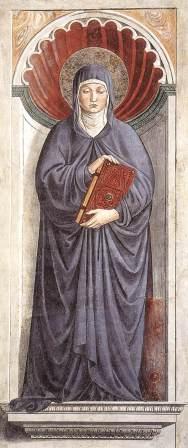
St. Monica
Benozzo Gozzoli, 1464-1465
Apsidal Chapel of
Sant' Agostino,
San Gimignano, Italy
The final days of August provide us, in our Church, an opportunity to reflect on family ties, patience, conversion, and the power of prayer. In our reflection, we come to learn more about God’s immense love and mercy, and to understand more profoundly that God’s timing is not necessarily our own. For in these final days of August we celebrate not only the feast day of one of the greatest Doctors (teachers) of the Church, but also of his mother. On August 28 we celebrate the Memorial of Saint Augustine, and the day before, on August 27, we celebrate the Memorial of Augustine’s mother, Saint Monica.
Tagaste in North Africa (in what is now Algeria) was the birthplace and home of Monica and her family. Monica, a Christian, was born in the early decades of the fourth century. Her parents arranged for her to marry Patricius, a pagan. Patricius had a very bad temper, and Monica, who certainly possessed the virtue of patience, dealt not only with him, but with his mother, who lived with them. In 354 Augustine, the son of Monica and Patricius, was born. He was also a handful! Let’s just say he was a very willful, and sometimes downright immoral, youth. He rejected the ways of Christians, and even followed the teachings of heretics.
Monica’s Christian faith sustained her. She had a deep prayer life, and never stopped praying for her family. The fruits of these prayers first became very evident when Monica’s husband Patricius, and his mother, left their pagan ways and converted to Christianity. Patricius died one year later.
Augustine was seventeen at the time of his father’s and grandmother’s conversion. But he did not give up his youthful, rebellious ways. For a while, Monica’s patience wore thin, and she cast out Augustine. But this did not last long, and soon she was not only praying for Augustine’s conversion, but fasting for this, as well. But Augustine was as willful and stubborn as Monica was faithful!
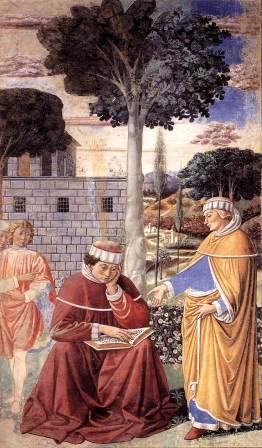
St. Augustine Reading the
Epistle of St. Paul
Benozzo Gozzoli, 1464-1465
Apsidal Chapel of
Sant' Agostino,
San Gimignano, Italy
Augustine studied at Carthage, and eventually in Rome, as well. When, at age twenty-nine, Augustine went to Rome, Monica followed him. (In fact, Augustine even played a trick on Monica to give her “the slip” so she wouldn’t go with him. But that didn’t deter Monica. It seems Augustine’s stubbornness was inherited from his mother!) However, by the time Monica arrived in Rome, Augustine had already left for Milan. So guess what city was next on Monica’s itinerary!
Now Ambrose (yes, Saint Ambrose whose feast we celebrate on December 7) was Bishop of Milan at that time. Ambrose became Monica’s spiritual advisor, and also gave spiritual counsel to Augustine. Now to interject a little trivia…Have you heard the saying, “When in Rome, do as the Romans do.”? That is actually a paraphrase of some advice Ambrose gave to Monica. Some of the Christian spiritual practices in Rome differed from what Monica had practiced in North Africa. She
wondered what she should do. So she consulted Ambrose, and got her answer!
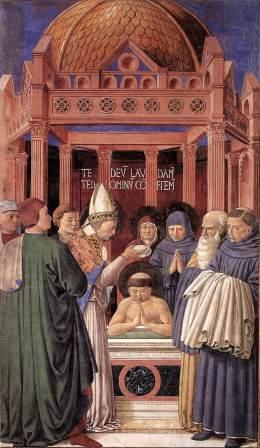
Baptism of St. Augustine
Benozzo Gozzoli, 1464-1465
Apsidal Chapel of Sant' Agostino,
San Gimignano, Italy
But back to our story of the still “pagan” Augustine... At this time, Augustine was living with his mistress and their son, Adeodatus. It is said that one day, while under a fig tree, Augustine heard the words, “Tolle, lege” (take it and read it). Saint Paul’s writing was handy, and Augustine read and meditated upon Romans 13:13-14. Through these words of Saint Paul, the Lord spoke powerfully to Augustine.
At Easter 387, Ambrose baptized both Augustine and his son, Adeodatus. Within the year, Augustine returned to his native land of North Africa. Monica died in Ostia before returning to her home. But even in her suffering, she died a happy death because her prayers for her son’s conversion had been answered.
Within a few short years of his baptism, Augustine became a priest, and then the Bishop of Hippo in North Africa. He was a founder of monastic life, was a prolific writer and preacher, and is remembered as one of the greatest Doctors (teachers) of our Church.
Augustine died in 430. His powerful writings are still read to this day. Some of his most famous works include his “Confessions”, “City of God”, and “The Trinity”. More than five hundred of his sermons are also still in existence. You can access an English translation of the “Confessions of Saint Augustine” here.
The tomb of Saint Augustine is located in Pavia, Italy in the Basilica of San Pietro in Ciel d'Oro (Saint Peter in Heaven Clothed in Gold). The reliquary which contains his relics is beautifully decorated and stories of Augustine’s life surround it. A chapel in the church is dedicated to Saint Monica. Below is a brief video by “Rome Reports”, “650 Years of the Magnificent Tomb of St. Augustine.” Saint Monica’s tomb is in Rome at the Basilica of Sant' Agostino (named for her son, Saint Augustine of Hippo).
Click on the image above to download our ICF handout, "Saints Augustine and Monica: A Lesson in Perseverance."
Click on the image above to download our ICF work sheet on Saints Augustine and Monica.
Saint Monica is the Patron Saint of mothers. Saint Augustine is the Patron Saint of theologians, scholars, biologists, typesetters and printers. Monica and Augustine remain powerful role models and intercessors for us today. Never cease to pray, and always remember… God’s timing is not necessarily our timing!
